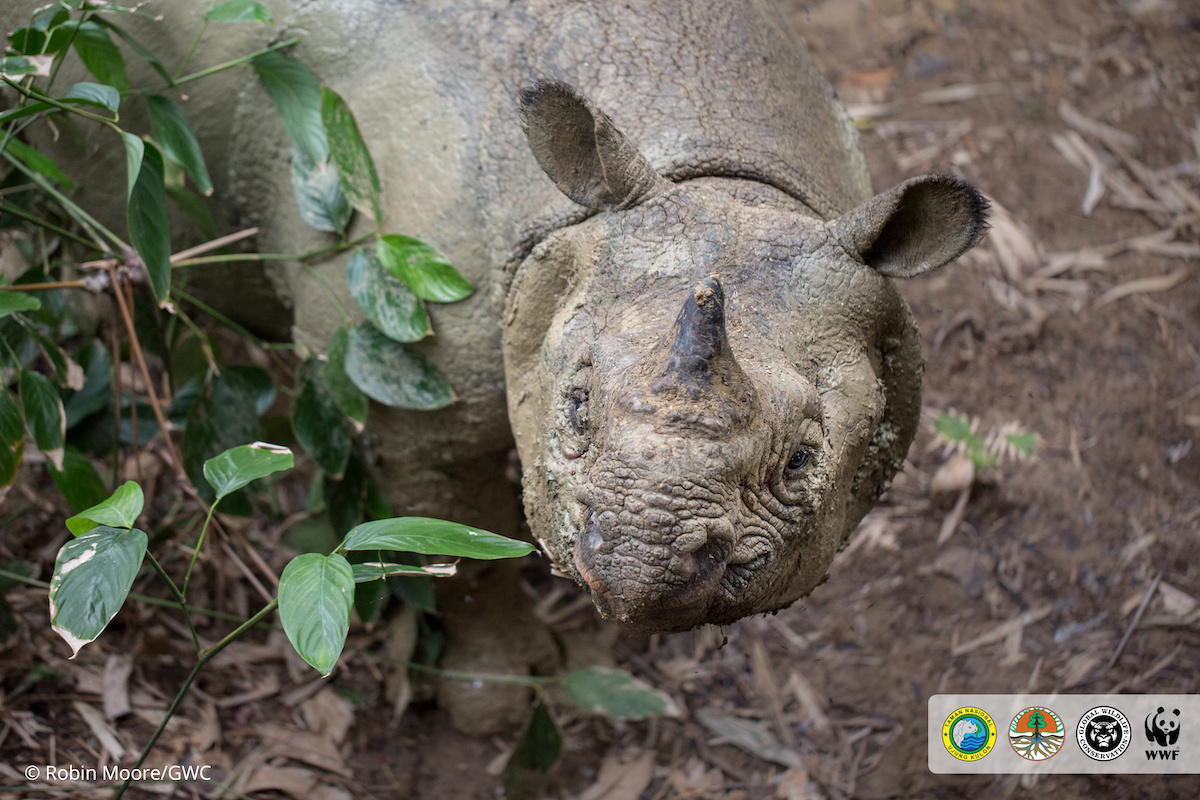

A critically endangered Javan rhino in Indonesia's Ujung Kulon National Park. Robin Moore / Global Wildlife Conservation
With only 68 individuals left on the planet, the Javan
rhino is the world’s most threatened rhino species.
So you can image the surprise when a team from
Global Wildlife Conservation and World Wildlife Fund (WWF) saw one of these incredible creatures wallowing in the mud in Indonesia’s Ujung Kulon National Park, the only place on Earth where these critically endangered species are found.
“We heard a crashing sound, and suddenly this rhino just appeared to the right of us,” said Robin Moore, the team member from Global Wildlife Conservation who took the photos, in a press release emailed to EcoWatch. “It was a surreal, once-in-a-lifetime moment, like time had stopped, and it was all we could do not to scare the animal away in our excitement.”
The rhino is known for its dusky grey color and a single horn that can be as long as 10 inches, according to WWF. Its skin has loose folds, making it look like armored plating.
“By sharing these photos, we hope to give people an emotional connection to this rare species—an animal that even rhino biologists only dream of getting a glimpse of in the wild,” said photographer Robin Moore. Robin Moore/Global Wildlife Conservation
Unlike white and black rhinos that live in Africa’s open grasslands and savannas, Javan rhinos live in thick forests, making them difficult to find and study—much less capture on camera.
These rhinos once roamed parts of India, Bhutan, Bangladesh, Myanmar, Thailand, Laos, Cambodia, Vietnam, Indonesia and Southern China. But the species has been hunted to near extinction for its horn that’s used in traditional medicine. Loss of its lowland habitat has also endangered the animals.
Due to poaching and habitat loss, only 20 of the animals were left in Ujung Kulon in the 1960s. Robin Moore/Global Wildlife Conservation
“This amazing footage of one of the world’s rarest animals is a reminder of how hard we must work to bend the curve on the decline of rare and iconic species like the Javan rhino,” Margaret Kinnaird, leader of WWF’s Wildlife Practice, said in the press release. “Last month, we released the Living Planet report showing a
60 percent decline in wildlife populations over the last generation, with poaching and habitat destruction among the greatest threats.”
Although the number 68 sounds small, it’s actually a considerable jump from the 1960s, when there were only 20 Javan rhinos left.
Still, since the remaining population has such a limited range, the Javan rhino is vulnerable to disease outbreak or natural disasters such as volcanic eruptions and tsunamis.
“Collaborative conservation efforts have resulted in rising Javan rhino numbers, underscoring the need to work together for common conservation goals. Javan rhinos are still far from secure and require continued efforts by the Indonesian government and its partners,” Kinnaird continued.
A Javan rhino in Indonesia’s Ujung Kulon National Park. Video by David Hermanjaya/WWF-Indonesia.
www.youtube.com
The Indonesian government works in partnership with WWF, Global Wildlife Conservation, the International Rhino Foundation and the Indonesian Rhino Foundation (YABI) to protect the animals.
Current conservation efforts include the establishment of Rhino Protection Units to prevent poaching and intensive population monitoring. In the future, conservationists hope to translocate individual rhinos to a new location to establish a second population elsewhere in Indonesia. They also intend to control the invasive Arenga palm, which shades out the forest floor and inhibits the growth of plants that the rhinos eat.
“We give thanks to the community surrounding the park in helping us to protect Javan Rhino,” Rahmat U Mamat, head of Ujung Kulon National Park, said in the press release. “The Javan rhino is a pride of Indonesia, so we should protect it from extinction.”
China Restores Rhino and Tiger Parts Ban After International Fury https://t.co/D8Wk8zbOSh
— Oceanic Preservation Society / OPS (@OP_Society) November 17, 2018

 233k
233k  41k
41k  Subscribe
Subscribe 

